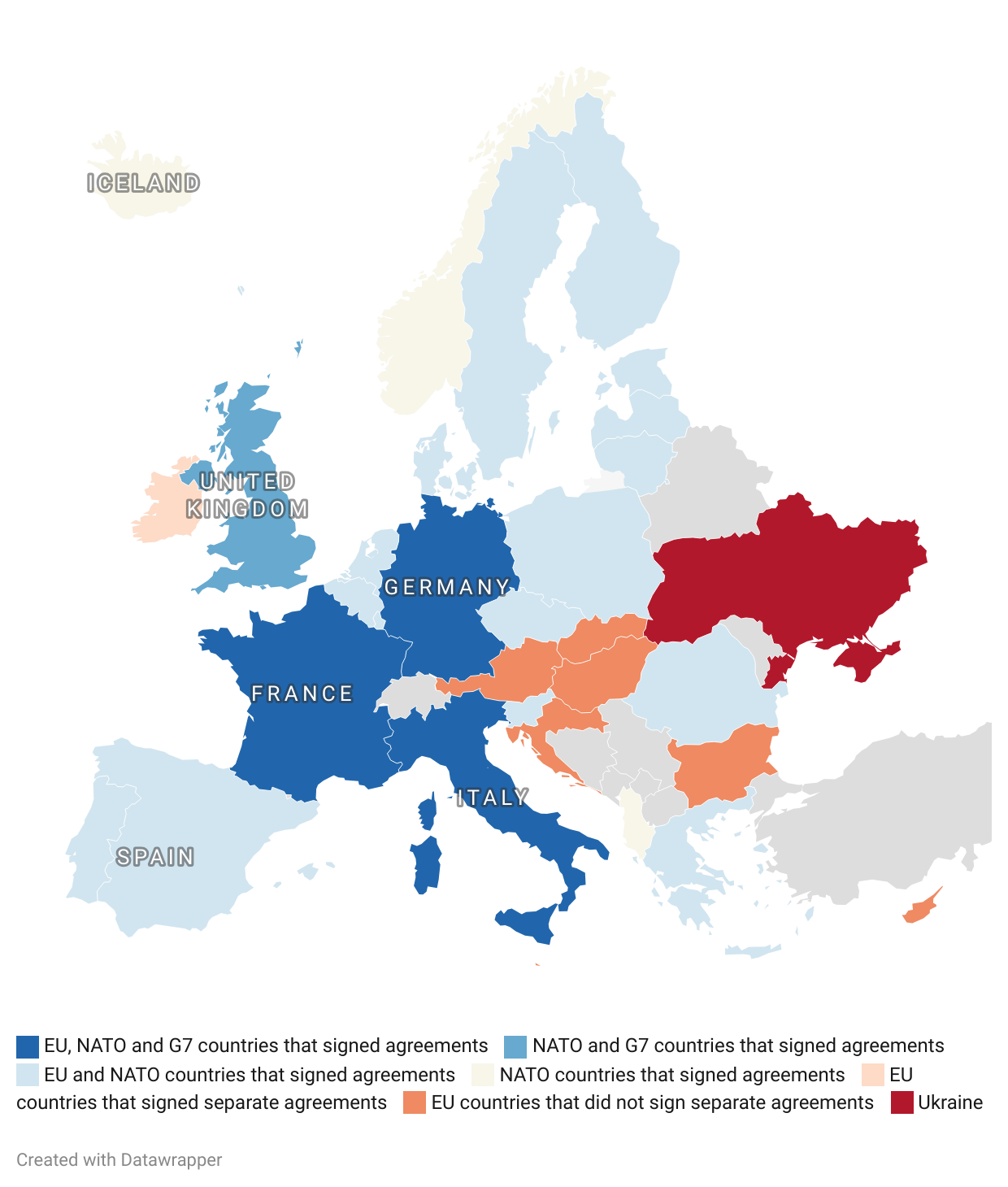Creation of the Ukrainian Army and first steps (1991-2004)
Following Ukraine’s declaration of independence in 1991, the country inherited from the USSR one of the largest armies in Europe with about one million military personnel (Figure 16.1), significant amounts of military equipment, and the world’s third-largest nuclear arsenal.
On August 24, 1991, the Verkhovna Rada adopted the resolution “On Military Formations in Ukraine,” establishing the control of the sovereign Ukrainian government over military units and creating the Ministry of Defense of Ukraine. The Presidential Decree “On the Defense Council of Ukraine” (September 3, 1991) defined the governance principles in the defense sector. On October 11, 1991, the Parliament approved the Concept of Defense and Armed Forces Development, which stipulated that Ukraine would gradually become a neutral and non-nuclear state, not participating in military alliances but adhering to all agreements on the non-use of nuclear weapons. The Armed Forces would have three branches: the Ground Forces, the Air Force, and the Navy.
The Armed Forces of Ukraine (AFU) were formally established by the law “On the Armed Forces of Ukraine” on December 6, 1991. The law “On the Defense of Ukraine” adopted on the same day defined the main principles of ensuring the country’s military security.
In 1992, Ukraine joined the Treaty on Conventional Armed Forces in Europe, which foresaw the reduction of military units and armaments.
Figure 16.1. Total strength of the AFU, thousand personnel
Source: Laws of Ukraine; until 1999 – resolutions of the Parliament of Ukraine
In the Military Doctrine adopted in 1993, the country declared a non-aligned status and a course toward reducing military capabilities. That same year, the army’s strength was reduced from 700,000 to 455,000 personnel.
A significant step was the signing of the Budapest Memorandum (1994), under which Ukraine relinquished its nuclear weapons in exchange for security guarantees from the United States, the United Kingdom, and Russia. By 1996, Ukraine’s nuclear arsenal was completely eliminated: by June 1, 1996, all nuclear warheads had been transferred to Russia. In 1999, Ukraine signed, and in 2005 ratified, the Ottawa Convention, under which it destroyed approximately 3 million anti-personnel mines. Over time, it became evident that the signed international treaties did not provide real security for our state.
In 1999, Ukraine and Russia signed an intergovernmental treaty, under which Ukraine transferred eight strategic bombers Tu-160, three Tu-95MS, and 575 Kh-55 cruise missiles to Russia in exchange for writing off the USD 275 million debt for supplied gas.
In the early 1990s, Ukraine and Russia had been negotiating the division of the Black Sea Fleet. The 1997 agreement determined that Ukraine would receive only 18% of the fleet while Russia would get 82%. Additionally, Russia was allowed to station its fleet in Sevastopol, which later became a springboard for Russian aggression in 2014.
In 2000, the President approved the State Program for the Reform and Development of the Armed Forces of Ukraine until 2005. The program aimed to reduce the army size to 295,000 personnel, decrease the number of military units, enhance the mobility of military formations, and develop a professional non-commissioned officer (NCO) corps.
In 2003, Parliament passed the Law “On Democratic Civilian Control over the Military Organization and Law Enforcement Agencies of the State,” establishing public and Parliamentary oversight over the Armed Forces of Ukraine. These reforms were part of Ukraine’s efforts to secure a NATO Membership Action Plan in the early 2000s. As a part of the process, Ukraine was implementing reforms, participating in joint exercises, and taking part in NATO missions, including operations in Iraq. However, the “Kolchuga scandal” (an alleged sale of an air defense system to Iran) significantly undermined NATO members’ trust in Ukraine.
Despite the conflict over Tuzla Island in 2003, Ukraine continued to reduce its army and sell off military equipment, including tanks, aircraft, and air defense systems. At the same time, no proper modernization of its own weaponry took place.
Euro-Atlantic course and attempts to professionalize the Army (2005-2010)
After the Orange Revolution, Ukraine declared its course toward NATO integration with plans for further modernization of the Armed Forces according to the Alliance standards. However, these plans were not fully implemented due to a lack of funding.
In 2004, the government approved the program of transition to a fully contract-based army by 2010. The aim was to professionalize the Armed Forces and enhance their combat readiness. However, the reform was never fully implemented due to poor planning. In 2005, the duration of compulsory military service was reduced from 18 to 12 months to increase the attractiveness of military service.
During this period, the army was further reduced: in 2007, it had 200,000 personnel, and by the end of 2010, it had decreased to 192,000. Along with the downsizing of the army, the sale of military equipment and the closure of military bases continued.
In 2005, the Ministry of Defense introduced the ‘White Book,’ an annual publication informing the public about the defense policy, the state and development of the Armed Forces of Ukraine. This publication promotes transparency and accountability in the military sphere (the latest issue was published in 2021).
In 2008, Ukraine and Georgia requested a NATO Membership Action Plan at the Bucharest Summit. However, due to pressure from Russia, Germany and the United States denied this request. Three months later, Russia attacked Georgia, and Ukraine provided military assistance to it.
Decline of the Army under Yanukovych and non-aligned status (2010-2014)
After Viktor Yanukovych was elected President in 2010, the course toward Euro-Atlantic integration was halted. In July 2010, Yanukovych signed a law on domestic and foreign policy principles, which declared Ukraine’s non-aligned status. The new Military Doctrine of Ukraine approved in June 2012 reinforced this non-aligned status and stated that Ukraine should seek assistance from international partners in the case of an attack.
The downsizing of the army continued: in 2013, its strength was 168,000 personnel, and by 2014, it had decreased to 157,500. A massive sell-off of military equipment significantly depleted Ukraine’s military stockpiles (Figure 16.2). The funds from these sales were not invested in modernization, so the army was effectively deprived of modern weaponry.
Figure 16.2. Weapon stockpiles, thousand, 1991-2021
Source: RBC
On October 1, 2013, Yanukovych canceled compulsory military service in Ukraine within the transition to a fully contract-based army. The last conscription took place in the fall of 2013. However, mandatory service was reinstated after the start of Russian aggression in 2014.
During Yanukovych’s presidency, individuals whose loyalty to Ukraine was questionable held the Minister of Defense position. Thus, Dmytro Salamatin, the Minister of Defense from February to December 2012, obtained Ukrainian citizenship only in 2005. Before that, he was a Russian citizen and left for Russia after the Revolution of Dignity. Pavlo Lebedyev served as Minister of Defense from December 2012 to February 2014, and then he also moved to Russia. According to former Chief of the General Staff Volodymyr Zamana, Lebedyev had Russian citizenship while serving as Ukraine’s Minister of Defense.
According to the State Bureau of Investigation, the unlawful downsizing of the Armed Forces was a key factor in the loss of Crimea in 2014. More than 70% of Ukrainian military personnel on the peninsula either sided with Russia or did not resist. Years of underfunding, personnel cuts, and neglect for strategic army development planning had weakened Ukraine’s defense. The interim Ukrainian government (including acting President Oleksandr Turchynov) lacked both the resources and international support to mount an armed resistance against the occupiers in Crimea. Russia was held back in eastern Ukraine in 2014-2015 thanks to the mobilization of volunteers. De-facto, Ukraine had to rebuild its army from scratch in the midst of war.
Since the government and a significant part of society were not preparing for the war under the influence of Russian propaganda that kept talking about “brotherly nations”, during 1991-2014 the Armed Forces were gradually reduced, with the ultimate goal of transitioning to a small professional army. The renunciation of nuclear weapons and the downsizing of the army was also part of Ukraine’s international commitments. However, the absence of a defense sector development strategy led to a critical weakening of the country’s combat capability, significantly reducing Ukraine’s ability to resist Russian aggression in 2014.
Reforms from 2014 to 2019
After the Revolution of Dignity and the beginning of Russia’s aggression in 2014, Ukraine needed to urgently transform its Armed Forces. As described above, before 2014 Ukrainian army was underfunded (Figure 16.3) and gradually downsized. In 2014, the Ministry of Defense budget was only UAH 15.2 billion (USD 1.3 billion or 1% of GDP). By 2019, it had increased to UAH 103 billion (USD 4 billion or 2.6% of GDP). Total expenditures on defense and security (including the army, police, SBU, and other security agencies) amounted to at least 5% of GDP from 2015 onwards.
The key areas of military reform included restoring combat capability, adopting NATO standards, and creating new organizational structures.
In 2014, Ukraine began the actual formation of territorial defense units. While the Territorial Defense Forces (TDF) had been legally established in 1991, until 2014 they existed mostly on paper, conducting no training or assemblies and only being allowed to operate during a special period (martial law). On April 30, 2014, acting President Oleksandr Turchynov announced the creation of territorial defense battalions in every oblast. As a result, 32 battalions and an experimental territorial defense brigade were formed.
Figure 16.3. Army funding in 1992-2021
Sources: Slovo i Dilo, openbudget.gov.ua. Note: Ukraine’s military expenditures have increased significantly since 2022. They amounted to USD 35.4 billion, or 22% of GDP in 2022, USD 57.2 billion, or 32% of GDP in 2023, and USD 57.6 billion, or 30% of GDP in 2024
In 2015, Ukraine approved a new Military Doctrine, officially identifying the Russian Federation as a military adversary. The doctrine also confirmed the rejection of non-aligned policy and restored the strategic course toward Euro-Atlantic integration, specifically NATO membership. On February 7, 2019, the Parliament enshrined the state’s strategic course toward full membership in the European Union and NATO in the Constitution.
In 2016, Ukraine outlined key priorities for defense sector reform until 2020. These included restructuring the Ministry of Defense and the General Staff, introducing new command and control systems, and preparing for full interoperability with NATO. Other priorities included modernizing military equipment, implementing NATO standards, and ensuring social protection for military personnel.
In 2015, the Ministry of Defense began reforming the military food supply system by introducing a product catalog and new standards aligned with NATO norms. This improved the quality and variety of soldiers’ diets, increased the assortment of fresh vegetables and fruits, meat, and dairy products. At the same time, the provision of military uniforms and gear was significantly enhanced.
Defense procurement reform began with the introduction of the Prozorro system in June 2015. In 2016, Parliament passed a law on the specifics of procuring goods, works, and services for defense needs, which accelerated procurement processes. For some time, procurement rules were frequently changed to balance transparency necessary for civic oversight of state funds use with military secrecy. Finally, in July 2020, the law “On Defense Procurement” established a comprehensive mechanism for this system.
The institutional structure of the defense sector was significantly reshaped. One of the key elements was the introduction of civilian control over the Armed Forces in 2018, in accordance with NATO standards. Within this process, the Ministry of Defense was reorganized, and civilians were appointed to leadership positions, including the Minister of Defense. The General Staff of the Armed Forces was also reformed by separating the functions of strategic and operational command. This allowed for more effective military management. In 2016, the Special Operations Forces (SOF), created in 2007 as a unit within the General Staff, became a separate branch of the Armed Forces. As a result, the effectiveness of special operations and the country’s defense capabilities have improved.
Between 2014 and 2019, other notable changes in the military sector were aimed at increasing the army’s combat readiness and improving service conditions for the military. Thus, salaries of the military were gradually increased. In 2014, the salaries of soldiers in the ATO zone on the first and second/third lines were UAH 5,600, while by 2019, they increased to UAH 23,500 and UAH 17,000, respectively.
Additional social guarantees were introduced for combat veterans, their pensions were increased, and one-time payments in case of injury or death of service members were raised as well. Other benefits included the provision of housing or respective financial compensation, subsidized housing loans, and free provision of land plots. Beyond financial compensation and land, an important change for veterans was establishing military rehabilitation centers and the first institutions for veteran psychological assistance.
Ukraine strengthened international cooperation through joint exercises and improved personnel training according to NATO standards. However, the same as today, the most influential NATO members strongly opposed Ukraine’s accession to the Alliance. In 2018, Ukraine was granted NATO aspirant status, confirming its aspiration for membership, but this status did not include any legally binding guarantees and did not bring Ukraine closer to obtaining a Membership Action Plan (MAP).
Thanks to 2014-2019 reforms, including increased military funding, institutional changes, alignment of the Armed Forces with NATO standards, improved logistical support, and enhanced social protection for service members, Ukraine’s defense capabilities significantly improved. The remaining challenges included an imperfect command system, corruption in defense procurement, and insufficient development of domestic arms production.
Volunteers and civil society organizations played a crucial role in restoring and modernizing the Armed Forces of Ukraine between 2014 and 2019. With the onset of Russian aggression in 2014, the volunteer movement became a key force in supplying the army with essential equipment, gear, and medical supplies. Although their financial contribution did not exceed 5% of the total, volunteers had the advantage of delivering necessary items more quickly or providing supplies that the state did not procure. Between 2014 and 2019, 13-23% of Ukrainians participated in the volunteer movement, with 60-70% of them supporting the army.
In addition to material support, civil society actively participated in the reform of the defense sector. In 2019, a working group of security and defence officials and civilian experts led by Major General Serhiy Kryvonos was established under the National Security and Defense Council. This group developed the concept of the Law “On Territorial Defense of Ukraine,” proposing the creation of a separate military formation — the Territorial Defense Forces of Ukraine — to involve citizens in national defense (the law was passed in 2021).
Thus, volunteers and civil society organizations not only provided the army with essential resources but also played an active role in shaping and implementing defense policy, contributing to the strengthening of Ukraine’s national security.
Army reforms in 2019-2024
Іn March 2021, Parliament established new approaches to mobilization training and personnel reserves. Military commissariats were replaced with Territorial Recruitment and Social Support Centers, and the process of maintaining military records for reservists was improved, including the introduction of the “Oberih” IT system (the Unified State Register of Conscripts, Persons Liable for Military Service, and Reservists).
In July 2021, Parliament adopted the law “On the Fundamentals of National Resistance.” According to this law, in January 2022, the Territorial Defense Forces were created. Territorial Defense Forces were the key factor that allowed to repel the first wave of the Russian aggression in February-March 2022.
After the start of the full-scale war on February 24, 2022, the Verkhovna Rada imposed martial law (inter alia, expanding the powers of military administrations) and declared general mobilization.
During martial law, the government significantly increased the financial support for the military. Soldiers on the frontline or implementing combat missions behind enemy lines receive an additional monthly payment of UAH 100,000. Additional social guarantees have been introduced for wounded soldiers, families of the fallen, and veterans (see Chapter 12).
Drones have been used in combat since 2014, primarily for reconnaissance. However, with the start of the full-scale invasion, their use increased significantly. One of the reasons for this was the shortage of ammunition: despite partners’ assistance, Ukraine has continuously faced the deficits of artillery shells. In addition to destroying enemy equipment and personnel, drones perform various other functions, including reconnaissance, artillery coordination, and disruption of enemy logistics, even deep in the rear. At the beginning of 2024, the President officially “legitimized” the role of drones in warfare by establishing the Unmanned Systems Forces as a separate branch of the military. A respective law was adopted later.
International cooperation
During 2024, Ukraine signed a series of bilateral security agreements to strengthen military cooperation and ensure mutual support during armed conflicts. The first agreements were signed with the United Kingdom, Germany, and France, followed by agreements with the United States and the European Union. The EU agreement establishes long-term commitments from all 27 member states to provide Ukraine with military, financial, humanitarian, and political support for ten years. This document also reaffirms the EU’s readiness to support Ukraine on its path to membership.
As of January 2025, 28 agreements have been signed: a Joint open Declaration on Support for Ukraine by G7 countries, 20 with counties who joined the declaration, and one with the European Union (Figure 16.4).
Figure 16.4. Countries with which Ukraine signed security agreements

Note: The US, Japan, and Canada, which are G7 members and signed security agreements with Ukraine, are not shown on the map
The security agreements signed by Ukraine serve, on the one hand, as a temporary alternative to full NATO membership and, on the other hand, as a safeguard in case of a potential crisis within the Alliance. Their actual effectiveness will depend on the political situation in the United States and Europe.
Despite some progress in strengthening security through bilateral and multilateral agreements, Ukraine continues to consider full NATO membership the only real guarantee of its security and a deterrent against further Russian aggression.
Reforms of 2019-2024 contributed to the transformation of the Armed Forces of Ukraine, but until 2022, changes often occurred despite, rather than due to, government actions. The key factors in strengthening the army after the full-scale invasion were not just government decisions but also the immense efforts of volunteers, who provided the military with essential equipment, technology, and support. At the same time, the army adapted to real combat challenges and deepened cooperation with NATO partners.
What next?
Between 2014 and 2024, the Ukrainian Armed Forces significantly transformed, their combat readiness and ability to respond to modern challenges largely increased. However, since the war is ongoing and there is no certainty about its end, further reforms are necessary.
In January 2025, during the meeting of the Ukraine-NATO Council, Commander-in-Chief of the Armed Forces of Ukraine Oleksandr Syrskyi presented the Ukrainian Army Strategy for 2025. The Strategy outlines four priorities: stabilizing the front line, strengthening Ukraine’s defense capabilities, enhancing air and maritime security, and providing an asymmetric response to the aggressor’s attempts to gain the advantage of scale. At the meeting, roadmaps for the development of Ukraine’s Defense Forces until 2027 were approved. These plans were developed within the framework of eight capability coalitions, focusing on aviation, air defense, naval capabilities, artillery, armored vehicles, IT systems, drones, and mine clearance.
To attract young people aged 18-25 to join the Ukrainian Armed Forces, a special program was introduced in February 2025, offering significant financial payments, housing, and educational benefits (however, some consider this program to be unfair). Moreover, Major General Mykhailo Drapatyi, the Ukrainian Ground Forces Commander, announced plans to transform the training, command, and recruitment system to address personnel shortages and eliminate corruption. Key priorities include improving training programs, implementing modern technologies, and expanding the role of the non-commissioned officer corps.
Along with developing the Defense Forces, the government plans to scale up the defense industry and improve military supply systems. The Minister of Strategic Industries of Ukraine, Herman Smetanin, reported that as of early 2025, Ukraine produces over one-third of the weapons required by the Armed Forces. Defense enterprises will focus on air defense systems and missile capabilities.
In the military supply area, a reform of the Armed Forces’ food system is planned. The Ministry of Defense is implementing a modern approach to improve reliability, transparency of the supplies and their responsiveness to the needs of the military. Initially, the new system was to be tested in five regions — Kyiv, Vinnytsia, Zhytomyr, Cherkasy, and Kirovohrad, as well as in Kyiv city. However, after the first procurement tenders under the new model received no bids from market participants, the Ministry of Defense decided to reduce the pilot project scale to Kyiv city and Kyiv oblast.
An important reform area is improving rehabilitation and medical care for military members. To address this, the government has approved the Strategy for the Transition from Military Service to Civilian Life until 2027.
In 2025 and the following years, the government plans to further reform the Armed Forces of Ukraine with an emphasis on enhancing combat readiness, improving command and logistical efficiency, and advancing the country’s integration into Euro-Atlantic security structures.
Photo: depositphotos.com/ua
Attention
The authors do not work for, consult to, own shares in or receive funding from any company or organization that would benefit from this article, and have no relevant affiliations



